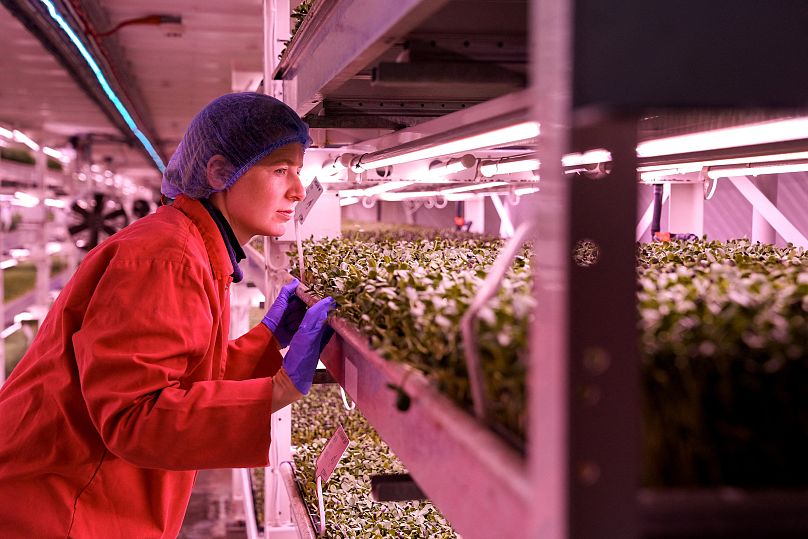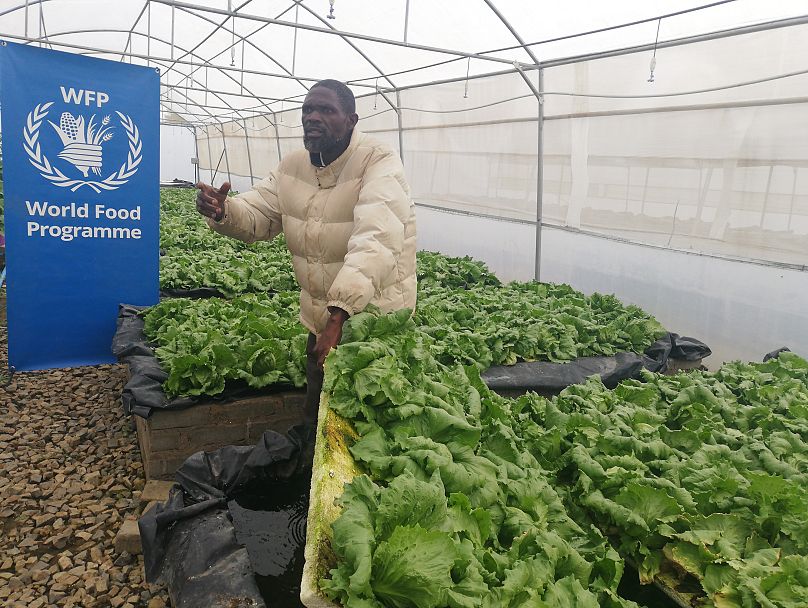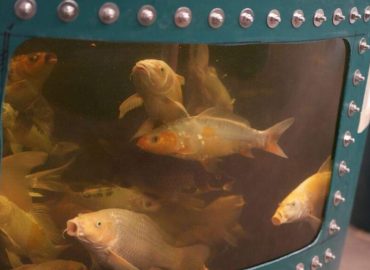Refugee camp using solar power and ‘hydroponics’ to grow thousands of fruit and veg

Refugee Hydroponics | By Farai Shawn Matiashe |
IMAGE: Francine Mashimango, a refugee holding eggplants in one of the greenhouses. – Copyright Farai Shawn Matiashe
48-year-old Francine Mashimango stands inside a greenhouse at a hydroponics station in Tongogara Refugee Camp (TRC) in southeastern Zimbabwe.
Wearing a white dress and a black jersey to protect herself from the brutal June cold, Mashimango is looking at a month-old lettuce grown in a deep water culture system of hydroponics.
The single mother of eight children fled conflict in the Democratic Republic of Congo in 2018.
After having passed through Zambia and getting arrested along with her children for breaking immigration laws in Binga in Zimbabwe’s north, she found sanctuary at TRC in Chipinge district.
“The rebels took my husband in 2016, forcing him to join them. Until now, I do not even know if he is still alive or not,” says Mashimango in Swahili.
Shacks and makeshifts make up most of the homes in TRC.
Mashimango – who was a smallholder farmer in DRC – tried to establish a backyard garden at her home in the camp but with no success as water is nearly a kilometre away, making her farming venture unsustainable.
In November 2021, she became one of the pioneer smallholder farmers in a hydroponic station established by World Vision Zimbabwe, a humanitarian organisation with funding from the UN World Food Programme (WFP).
What is hydroponics?
Hydroponics, a soilless cultivation technique that enables plant growth in arid areas or in urban areas, uses up to 90 per cent less water and 75 per cent less space than conventional farming.
Hydroponics techniques also encourage plants to grow up to two times faster, according to an WFP expert.
At TRC there are about 70 farmers who grow various vegetables and fruits such as tomatoes, cucumbers and lettuce in greenhouses in an area the size of a football field powered by solar energy.
They use two types of hydroponics systems including the deep water culture (DWC) and the drip system also known as the Dutch bucket system.

Above: Hydroponic technology is taking off in various settings – including a disused World War Two bunker in London.MAJA SMIEJKOWSKA/REUTERS
“Deep Water Culture is one of the most simple and efficient hydroponics techniques,” explains a World Food Programme official. “The plant grows in a net pot filled with a small number of clay pebbles. The roots develop immersed in a water-based mineral solution constantly that is oxygenated by an air pump.”
The Dutch bucket system, the official adds, uses two or more growing containers connected to the same irrigation and drainage lines that provide oxygenation and nutrients.
The leftover solution then flows back into the reservoir for reuse.
Mashimango, who is part of the team doing routine check-ups every morning, says the hydroponic technique requires less labour.
“I do not have to carry buckets on top of my head to water the plant. We rarely do anything here. I use the time elsewhere,” says Mashimango cracking jokes in her mother tongue Swahili.
How productive is hydroponics?
The hydroponic project at TRC has a capacity to produce about 11,800 heads of lettuce and 500 cucumber plants in one harvesting cycle in the five greenhouses, according to the WFP.
Louis Muhigirwa, a deputy Food and Agriculture Organisation representative in Zimbabwe, says hydroponics is an option for farmers with limited access to land and water and works well in places with poor soils.
“It is a potentially useful tool to overcome some of the challenges of traditional agriculture in the face of freshwater shortages, climate change and soil degradation in urban areas, arid climates and low-lying islands,” he says.
What happens on cloudy days?

Above: Peter Banzvi Chakaamba, a smallholder farmers inspecting lettuce in one of the greenhouse at Tongogara Refugee Camp.Farai Shawn Matiashe
Both systems at TRC require power to keep on supplying oxygen and nutrients to the plants. A constant power supply is also needed to power the automated machines that control the temperature in the greenhouse.
Solar panels charge batteries that pump water from underground to tanks. The water is then pumped to the hydroponics system in the greenhouse.
“When it is cloudy the system shuts down after the batteries run out of power,” says Peter Banzvi Chakaamba, 48, who arrived in TRC four years ago after fleeing conflict in neighbouring Mozambique.
More solar panels and better storage is needed to ensure they do not run out of power during cloudy days.
Muhigirwa adds that some types of hydroponic systems also require a continuous and reliable power supply, as plant roots can dry out quickly if pumps or sprays fail.
Continue Reading the Original Article: https://www.euronews.com/green/2022/12/04/inside-the-refugee-camp-using-solar-power-and-hydroponics-to-grow-thousands-of-fruit-and-v
The post Refugee camp using solar power and ‘hydroponics’ to grow thousands of fruit and veg appeared first on GROZINE.


